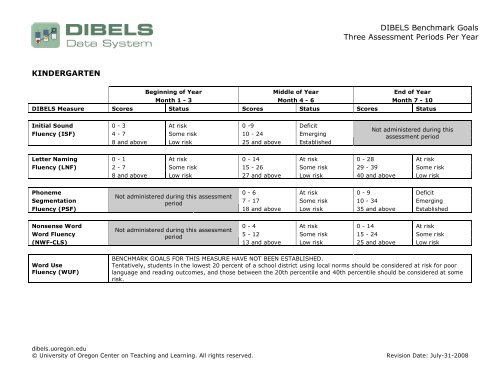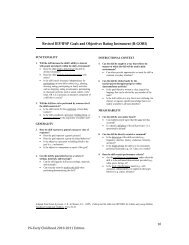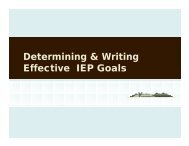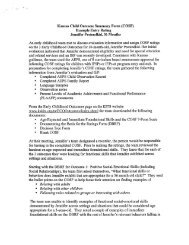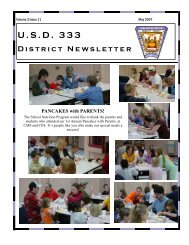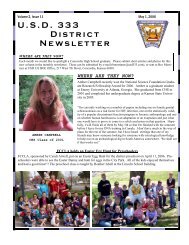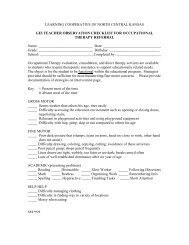DIBELS Benchmark Goals Three Assessment Periods Per Year ...
DIBELS Benchmark Goals Three Assessment Periods Per Year ...
DIBELS Benchmark Goals Three Assessment Periods Per Year ...
Create successful ePaper yourself
Turn your PDF publications into a flip-book with our unique Google optimized e-Paper software.
<strong>DIBELS</strong> <strong>Benchmark</strong> <strong>Goals</strong><strong>Three</strong> <strong>Assessment</strong> <strong><strong>Per</strong>iods</strong> <strong>Per</strong> <strong>Year</strong>KINDERGARTENBeginning of <strong>Year</strong> Middle of <strong>Year</strong> End of <strong>Year</strong>Month 1 - 3 Month 4 - 6 Month 7 - 10<strong>DIBELS</strong> Measure Scores Status Scores Status Scores StatusInitial Sound 0 - 3 At risk 0 -9 DeficitFluency (ISF) 4 - 7 Some risk 10 - 24 Emerging8 and above Low risk 25 and above EstablishedNot administered during thisassessment periodLetter Naming 0 - 1 At risk 0 - 14 At risk 0 - 28 At riskFluency (LNF) 2 - 7 Some risk 15 - 26 Some risk 29 - 39 Some risk8 and above Low risk 27 and above Low risk 40 and above Low riskPhoneme 0 - 6 At risk 0 - 9 DeficitNot administered during this assessmentSegmentationperiod7 - 17 Some risk 10 - 34 EmergingFluency (PSF)18 and above Low risk 35 and above EstablishedNonsense Word 0 - 4 At risk 0 - 14 At riskNot administered during this assessmentWord Fluencyperiod5 - 12 Some risk 15 - 24 Some risk(NWF-CLS)13 and above Low risk 25 and above Low riskWord UseFluency (WUF)BENCHMARK GOALS FOR THIS MEASURE HAVE NOT BEEN ESTABLISHED.Tentatively, students in the lowest 20 percent of a school district using local norms should be considered at risk for poorlanguage and reading outcomes, and those between the 20th percentile and 40th percentile should be considered at somerisk.dibels.uoregon.edu© University of Oregon Center on Teaching and Learning. All rights reserved. Revision Date: July-31-2008
<strong>DIBELS</strong> <strong>Benchmark</strong> <strong>Goals</strong><strong>Three</strong> <strong>Assessment</strong> <strong><strong>Per</strong>iods</strong> <strong>Per</strong> <strong>Year</strong>FIRST GRADEBeginning of <strong>Year</strong> Middle of <strong>Year</strong> End of <strong>Year</strong>Month 1 - 3 Month 4 - 6 Month 7 - 10<strong>DIBELS</strong> Measure Scores Status Scores Status Scores StatusLetter Naming 0 - 24 At riskFluency (LNF) 25 - 36 Some risk37 and above Low riskNot administered during this assessmentperiodNot administered during thisassessment periodPhoneme 0 - 9 Deficit 0 - 9 Deficit 0 - 9 DeficitSegmentation 10 - 34 Emerging 10 - 34 Emerging 10 - 34 EmergingFluency (PSF) 35 and above Established 35 and above Established 35 and above EstablishedNonsense Word 0 - 12 At risk 0 - 29 Deficit 0 - 29 DeficitFluency 13 - 23 Some risk 30 - 49 Emerging 30 - 49 Emerging(NWF-CLS) 24 and above Low risk 50 and above Established 50 and above EstablishedOral Reading 0 - 7 At risk 0 - 19 At riskNot administered during thisFluency (ORF)assessment period8 - 19 Some risk 20 - 39 Some risk20 and above Low risk 40 and above Low riskRetell Fluency(RTF)Not administered during thisassessment periodBENCHMARK GOALS FOR THIS MEASURE HAVE NOT YET BEEN ESTABLISHED.Preliminary evidence indicates that for students to be on track withcomprehension they should meet both of the following criteria: 1) meet the OralReading Fluency benchmark goal and 2) have a retell score of at least 25% oftheir Oral Reading Fluency score.Word UseFluency (WUF)BENCHMARK GOALS FOR THIS MEASURE HAVE NOT BEEN ESTABLISHED.Tentatively, students in the lowest 20 percent of a school district using local norms should be considered at risk for poorlanguage and reading outcomes, and those between the 20th percentile and 40th percentile should be considered at somerisk.dibels.uoregon.edu© University of Oregon Center on Teaching and Learning. All rights reserved. Revision Date: July-31-2008
<strong>DIBELS</strong> <strong>Benchmark</strong> <strong>Goals</strong><strong>Three</strong> <strong>Assessment</strong> <strong><strong>Per</strong>iods</strong> <strong>Per</strong> <strong>Year</strong>FOURTH GRADE Beginning of <strong>Year</strong> Middle of <strong>Year</strong> End of <strong>Year</strong>Month 1 - 3 Month 4 - 6 Month 7 - 10<strong>DIBELS</strong> Measure Scores Status Scores Status Scores Status<strong>DIBELS</strong> Oral 0 - 70 At risk 0 - 82 At risk 0 - 95 At riskReading Fluency (ORF) 71 - 92 Some risk 83 - 104 Some risk 96 - 117 Some risk<strong>DIBELS</strong> RetellFluency (RTF)93 and above Low risk 105 and above Low risk 118 and above Low riskBENCHMARK GOALS FOR THIS MEASURE HAVE NOT BEEN ESTABLISHED.*FIFTH GRADE Beginning of <strong>Year</strong> Middle of <strong>Year</strong> End of <strong>Year</strong>Month 1 - 3 Month 4 - 6 Month 7 - 10<strong>DIBELS</strong> Measure Scores Status Scores Status Scores Status<strong>DIBELS</strong> Oral 0 - 80 At risk 0 - 93 At risk 0 - 102 At riskReading Fluency (ORF) 81 - 103 Some risk 94 - 114 Some risk 103 - 123 Some risk<strong>DIBELS</strong> RetellFluency (RTF)104 and above Low risk 115 and above Low risk 124 and above Low riskBENCHMARK GOALS FOR THIS MEASURE HAVE NOT BEEN ESTABLISHED.*SIXTH GRADE Beginning of <strong>Year</strong> Middle of <strong>Year</strong> End of <strong>Year</strong>Month 1 - 3 Month 4 - 6 Month 7 - 10<strong>DIBELS</strong> Measure Scores Status Scores Status Scores Status<strong>DIBELS</strong> Oral 0 - 82 At risk 0 - 98 At risk 0 - 103 At riskReading Fluency (ORF) 83 - 108 Some risk 99 - 119 Some risk 104 - 124 Some risk<strong>DIBELS</strong> RetellFluency (RTF)109 and above Low risk 120 and above Low risk 125 and above Low riskBENCHMARK GOALS FOR THIS MEASURE HAVE NOT BEEN ESTABLISHED.**Preliminary evidence indicates that children's retell scores should typically be about 50% of their oral reading fluency score, and that it is unusual forchildren reading more than 40 words per minute to have a retell score 25% or less than their oral reading fluency score. A retell score of less than 25%of the oral reading fluency score may indicate a problem with comprehension.dibels.uoregon.edu© University of Oregon Center on Teaching and Learning. All rights reserved. Revision Date: July-31-2008
<strong>DIBELS</strong> <strong>Benchmark</strong> <strong>Goals</strong><strong>Three</strong> <strong>Assessment</strong> <strong><strong>Per</strong>iods</strong> <strong>Per</strong> <strong>Year</strong>Note: <strong>Goals</strong> and cutpoints for risk for Grades 4 through 6 are based on CBM normative information from 4th and 5th grade students inFall, Winter and Spring from Hasbrouck and Tindal (1992) as well as average slope of reading progress information from Fuchs, Fuchs,Hamlett, Walz, & Germann (1993). Empirical evidence of the percent achieving subsequent literacy goals is not yet available for theseinitial estimates.In addition to these preliminary estimates of goals and risk indicators, local normative information is available for each participatingschool district. A reasonable approximation of goals and cut scores for risk are also available from the local norms. The 40th percentileusing local norms provides an approximate goal, and below the 20th percentile using local norms provides an approximate at-riskindicator.With additional research these preliminary estimates will be refined based on the odds of achieving subsequent literacy goals. Eachdistrict can examine these odds by entering scores on a selected outcome for relevant grade levels. For example, in Oregon, a stateassessment is given in fifth grade with a specific goal for meeting expectations. If a participating school district enters the fifth gradescores for all fifth grade students and the Oregon State <strong>Assessment</strong> goal, the <strong>DIBELS</strong> Data System will provide the odds of achievingthe goal for these initial estimates of goals and risk indicators.ReferencesFuchs, L. S., Fuchs, D., Hamlett, C. L., Walz, L., & Germann, G. (1993). Formative evaluation of academic progress: How much growthcan we expect? School Psychology Review, 22, 27-48.Hasbrouck, J. E., & Tindal, G. (1992, Spring). Curriculum-based oral reading fluency norms for students in grades 2 through 5. TeachingExceptional Children, pp. 41-44.dibels.uoregon.edu© University of Oregon Center on Teaching and Learning. All rights reserved. Revision Date: July-31-2008


